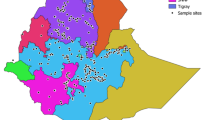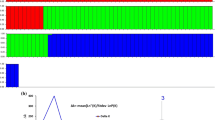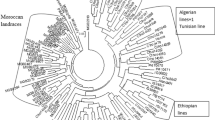Abstract
Wild barley, Hordeum spontaneum is the progenitor of cultivated barley. The center of diversity is in the Fertile Crescent in the Near East, where wild barley grows under a wide range of environmental and climatic conditions. Jordan wild barley is expected to harbor important genes that could be used for the improvement of the cultivated varieties especially in their tolerance to drought. To assess genetic diversity and allelic variation of Jordanian wild barley, 103 wild barley genotypes collected from different parts of Jordan along with 29 cultivated barley genotypes were analyzed for diversity by means of Simple Sequence Repeats (SSR). The spontaneum genotypes were grouped into six populations according to their longitude, latitude, altitude, and rainfall zone of the sites from where they have been collected, and the cultivated in one population. All barley genotypes were analyzed with 11 SSR markers with known sequences and chromosomal locations. The 11 microsatellite markers revealed 237 alleles, with an average of 21.5 alleles per locus. In spontaneum genotypes, 209 alleles were identified with an average of 19 alleles per locus, whereas, cultivated genotypes had 95 alleles with an average of 8.6 alleles per locus. Moreover, 52 alleles were identified in spontaneum (22 %) of the total alleles and 22 alleles in cultivated barley (9 %). The level of genetic diversity was very high; in fact, mean in total gene diversity (Ht) was 0.86 ranging from 0.72 to 0.94. Average gene diversity (H) was 0.79 ranging from 0.74 to 0.82. Genetic variation within population was much higher than among populations at molecular levels: this was also supported by the finding that morphological characters such as awn length, plant height, days to maturity, peduncle length, peduncle extrusion and tillering number, showed higher variation within populations than among populations. Clustering of populations was according to their ecological geographical pattern.


Similar content being viewed by others
References
Baek HJ, Beharav A, Nevo E (2003) Ecological-genomic diversity of microsatellites in wild barley, Hordeum, populations in Jordan. Theor Appl Genet 106:397–410
Baum BR, Nevo E, Jonson DA, Beiles A (1997) Genetic diversity in wild barley (Hordeum spontaneum C. Koch) in the Near East: a molecular analysis using random amplified polymorphic DNA (RAPD) markers. Genet Resour Crop Evol 44:147–157
Baum M, Grando S, Backes G, Jahoor A, Sabbagh A, Ceccarelli S (2003) QTL for agronomic traits in the Mediterranean environment identified in recombinant inbred lines of the cross ‘Arta’ x H. 41-1. Theor Appl Genet 107:1215–1225
Baum M, Grando S, Ceccarelli S (2004). Localization of quantitative trait loci for dryland characters in barley by linkage mapping. Crop Science Society of America and American society of Agronomy. Challenges and Strategies for Drylnd Agriculture. CSSA special publication no. 32
Beckmann JS, Soller M (1990). Toward a unified approach to genetic mapping of eukaryotes based on sequence tagged microsatellite sites. Nat Biotechnol 8:930–932
Bedada G, Westerbergh A, Nevo E, Korol A, Schmid KJ (2014) DNA sequence variation of wild barley Hordeum spontaneum (L.) across environmental gradients in Israel. Heredity 112:646–655
Crosatti C, Nevo E, Stanca AM, Cattivelli L (1996) Genomic analysis of the accumulation of COR14 proteins in wild barley (Hordeum) and cultivated barley. Theor Appl Genet 93:975–981
Dreiseitl A, Dinoor A (2004) Phenotypic diversity of barley mildew resistance sources. Genet Resour Crop Evol 51:251–257
Ellis RP, Foster BP, Robinson D, Handley LL, Gordon DC, Russell JR, Powell W (2000) Wild barley: a source of genes for crop improvement in the twenty first century? J Exp Bot 51:9–17
Faccioli P, Grossi M, Pecchioni N, Vale G, Stanca A.M (1998). Barley evolution. In: Scarascia GJ, Pagnotta MA (eds). Italian contribution to plant genetics and breeding, xv congress of Eucarpia 21–25 September, 1998 Viterbo, Italy
Fu YB, Horbach C (2012) Genetic diversity in a core subset of wild barley germplasm. Diversity 4:239–257
Grossi M, GiorniE Rizza F, Stanca MA, Cattivelli L (1998) Wild and cultivated barleys show differences in the expression pattern of a cold-regulated gene family under different light and temperature conditions. Plant Mol Biol 38:1061–1069
Harlan JR, Zohary D (1966) Distribution of wild wheats and barley. Science 153:1074–1080
Hübner S, Höffken M, Oren E, Haseneyer G, Stein N, Graner A, Schmid K, Fridman E (2009) Strong correlation of wild barley (Hordeum spontaneum) population structure with temperature and precipitation variation. Mol Ecol 18(7):1523–1536
Ivandic V, Hackett CA, Nevo E, Keith R, Thomas TB (2002) Analysis of sequence repeats (SSRs) in wild barley from the Fertile Crescent: associations with ecology, geography and flowering time. Plant Mol Biol Evol 48:511–527
Jana S, Pietrzak LN (1988) Comparative assessment of genetic diversity in wild and primitive cultivated barley in center of diversity. Genetics 119:981–990
Jaradat AA (1991) Grain protein variability among populations of wild barley (Hordeum C. Koch) from Jordan. Theor Appl Genet 83:164–168
Kimura M, Crow JF (1964) The number of alleles that can be maintained in a finite population. Genetics 49:725–738
Korff VM, Wang H, Leon J, Pillen, K (2004). Detection of QTL for agronomic traits in an advanced backcross population with introgression from wild barley (Hordeum vulgare ssp.). In: Genetic variation for plant breeding, proceeding of the 17th EUCARPIA General Congress, Tulln, Austria, 8–11 September, 2004, pp 207–211
Lakew B, Henry RJ, Eglinton Baum M, Ceccarelli S, Grando S (2013) SSR analysis of introgression of drought tolerance from the genome of Hordeum spontaneum into cultivated barley (Hordeum vulgare ssp. vulgare). Euphytica 191:231–243
Li JZ, Huang XO, Heinrichs F, Ganal MW (2005) Analysis of QTLs for yield, yield components, and malting quality in a BC3-DH population of spring barley. Theor Appl Genet 110:356–363
Litt M, Luty JM (1989) Hypervariable microsattelite revealed by in vitro amplification of a dincleotide repeat within the cardiac muscle actin gene. Am J Hum Genet 44:397–401
Lu Z, Neumann P.M, TamarK, Nevo E (1999). Physiological characterization of drought tolerance in wild barley (Hordeum spontaneum) from the Judean Desert. http://wheat.pw.usda.gov/ggpages/bgn/29/a29-09.html
Matus IA, Hayes PM (2002) Genetic diversity in three groups of barley germplasm assessed by simple sequence repeats. Genome 45:1095–1106
Nei M (1973) Analysis of gene diversity in subdivided populations. Proc Natl Acad Sci USA 70:3321–3323
Nei M (1978) Estimation of average hetrozygosity and genetic distance from small number of individuals. Genetics 89:583–590
Nei M (1987) Molecular evolutionary genetics. Columbia University Press, New York
Nevo E, Baum B, Beiles A, Johnson D (1998) Ecological correlates of RAPD DNA diversity of wild wild barley, Hordeum spontaneum, in the Fertile Crescent. Genet Resour Crop Evol 45:151–159
Nevo E, Chen G, Suprunova T, Krugman T, Fahima T (2004) Ecogeographic and genetic determinates of kernel weight and colour of wild barley (Hordeum spontaneum) populations in Isreal. Seed Science Research 14:137–146
Ramsay L, Macaulay M, Ivanissevich SGD, Maclean K, Cradle L, Fuller J, Edwards KJ, Tuvesson S, Morgante M, Massari A, Maestri E, Mamiroli N, Sjakste T, Ganal M, Powell W, Waugh R (2000) A simple sequence repeat-based linkage map of barley. Genetics 156l:1997–2005
Saghai-Maroof MA, Biyashev RM, Yang GP, Zhang Q, Allard W (1994) Extraordinary polymorphic microsatellite DNA in barley: species diversity, chromosomal locations, and population dynamics. Proc Natl Acad Sci USA 91:5466–5470
Shakhatreh Y (2006). Genetic diversity assessment among Jordanian wild barley, (Hordeum spontaneum) genotypes and relationship with morphological traits revealed by SSR molecular markers. Ph.D. Thesis, Faculty of Agriculture, University of Jordan. Amman, Jordan
Shakhatreh Y, Haddad N, Alrababah M, Grando S, Ceccarelli S (2010) Phenotypic diversity in wild barley (Hordeum vulgare L. ssp. spontaneum (C. Koch) Thell.) accessions collected in Jordan. Genet Resour Crop Evol 57:131–146
Takahashi H, Sato K, Takeda K (2001) Mapping genes for deep-seedling tolerance in barley. Euphytica 122:37–43
Tatuz D, Renz M (1984) Simple sequences are ubiquitous repetitive component of eukaryotic genomes. Nucleic Acids Res 25:4127–4138
Turpeinen T, Vanhala T, Nevo E, Nissila E (2003) AFLP genetic polymorphism in wild barley (Hordeum spontaneum) populations in Israel. Theor Appl Genet 106:1333–1339
Varshney RK, Marcel TC, Ramsay L, Russell J, Röder MS, Stein N, Waugh R, Langridge P, Niks RE, Graner A (2007) A high density barley microsatellite consensus map with 775 SSR loci. Theor Appl Genet 114:1091–1103
Varshney RK, Thiel T, Sretenovic-Rajicic T, Baum M, Valkuon J, Guo P, Grando S, Ceccarelli S, Graner A (2008) Identification and validation of a core set of informative genic SSR and SNP markers for assaying functional diversity in barley. Mol Breed 22:1–13
Volis S, Mendlinger S, Ward D (2002) Adaptive traits of wild barley of Mediterranean and desert origin. Oecologia 133:131–138
von Bothmer R, Van Hintum H, Knüpffer H, Sato K (2003) Diversity in barley (Hordeum vulgare), vol XVII. Elsevier, Amsterdam, pp 129–136
Acknowledgments
Thanks are extended to the National Center for Agricultural Research and Extension (NCARE) for financing the study and to ICARDA for providing the germplasm and co-financing the laboratory work. Co-financing at ICARDA came from project (No. 2002.7860.6-001.00 and Contract No. 1060503) sponsored by BMZ (Bundesministerium für Wirtschaftliche Zusammenarbeit und Entwicklung), Germany.
Author information
Authors and Affiliations
Corresponding author
Rights and permissions
About this article
Cite this article
Shakhatreh, Y., Baum, M., Haddad, N. et al. Assessment of genetic diversity among Jordanian wild barley (Hordeum spontaneum) genotypes revealed by SSR markers. Genet Resour Crop Evol 63, 813–822 (2016). https://doi.org/10.1007/s10722-015-0285-8
Received:
Accepted:
Published:
Issue Date:
DOI: https://doi.org/10.1007/s10722-015-0285-8




